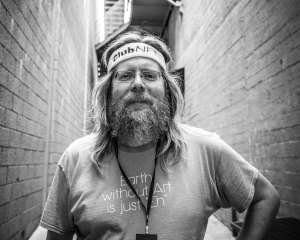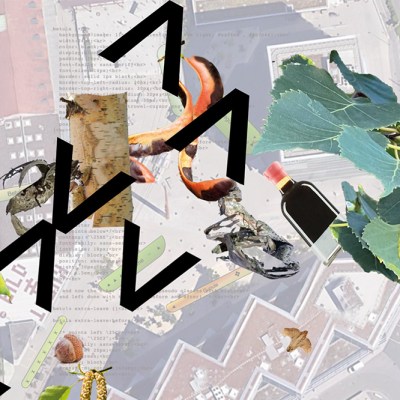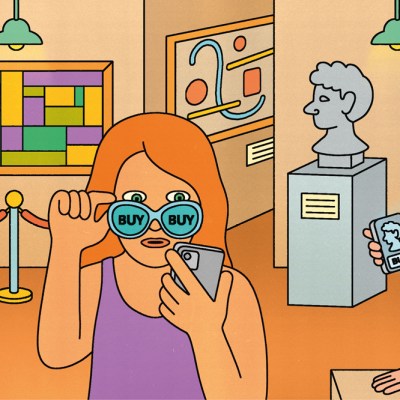It’s 18 months since Christie’s sold a non-fungible token (NFT) by the graphic artist Beeple for $69m and almost a year since Bloomberg reported that the NFT art market hit a $17bn high. Since then, the market has slumped to under $500m — another casualty of the crypto crash that has seen more than $2trn wiped off the value of cryptocurrency.
The collapse of FTX, the third largest centralised crypto trading exchange, has only added to the uncertainty around cryptocurrencies and NFTs. All of this has been greeted with a degree of schadenfreude by some individuals in the art world who regarded NFTs as mediocre art at best and as an out-and-out financial scam at worst. But as our latest analysis in the December issue of Apollo reveals, art and crypto have a more complicated relationship. Here, Jane Morris speaks to five leading figures in the digital art world about the impact of the crash and the future of NFTs.
Alex Estorick
This isn’t the first crypto crash, but what’s striking this time is the weight of the community now invested in replacing the hype with critical frameworks that ground NFTs in the history of generative art and digital art.
Current developments exist within histories that go much further back than 2012. Sol LeWitt wrote instructions, or algorithms, for others to execute his work, while Andy Warhol was preoccupied with the computer as a tool to produce automatic outputs. Early computer artists like Vera Molnár (b. 1924), Frieder Nake (b. 1938) and Manfred Mohr (b. 1938) were producing generative art at the same time but were ignored by the mainstream art world.
Perhaps, though, one of greatest services of the NFT is to make the relationship between art and money transparent. This is an immense relief because, historically, contemporary art has either concealed or fetishised that relationship. The idea of art as a financial vehicle is far from new.
Alex Estorick is the editor-in-chief of the online magazine Right Click Save (RCS), which launched earlier this year.
Nicole Sales Giles

Nicole Sales Giles
The downturn in cryptocurrencies has definitely had an effect in terms of the volume that we are experimenting with selling. But it’s a positive in the long run if it results in fewer people buying for pure investment. We’re seeing less gambling going on in terms of whether a particular artwork or project will appreciate in value and more of a focus on ‘art for art’s sake’.
NFTs are certainly bringing in new clients. For our inaugural sale on Christie’s 3.0 (the auction house’s NFT platform), 70 per cent of our buyers were new. They are also crossing over and buying things in our other categories, particularly some of our luxury categories like wine and watches. The collectors have generally been very successful in some sort of digital of environment, whether it’s crypto, blockchain or more traditional tech.
There are some great artists making NFTs, but on a personal level, I don’t know if I really care what’s called art or not. From a Christie’s perspective, we’re always focused on bringing the highest end of luxury to market, in whatever categories our clients want to collect.
Nicole Sales Giles is the director of digital art sales at Christie’s.
Steven Sacks
The explosion of NFTs was the most disruptive thing that’s happened in 20 years of business. We exhibit and sell media art with a historical context and a focus on the art experience: how the work is presented, what is the artist’s intention in presenting their work. At first it felt as if everything we’d been working on for 20 years was going to be discarded by people buying a JPEG and building a collection on their phones. And for most of those people the main motivation was: when is it going to go up in value? When am I going to flip it? Instead of an emotional connection to acquiring an artwork that has conceptual rigour and is something important in their lives.
Initially I saw NFTs as mainly a vehicle for my artists to promote their work to a new, very large audience, as the market for media art prior to NFTs was comparatively small. I was also able to discover interesting artists through NFTs. One of our artists, Refik Anadol has exploded in the NFT marketplace. He also wanted to connect to the fine art world and well-known artists in the digital field. Many NFT artists are starting to care about that – about understanding the value of physical space, and having their work presented in thoughtful, engaging ways. That’s how they will evolve, versus the frenzy around having an art collection on your phone.
What’s amazing is that after 20 years the market could exponentially grow. What’s negative is a serious lack of understanding about the history of media art. The value system at the moment looks a bit broken when work by a 20 year old can sell for many times the amount of the great media art pioneers.
Steven Sacks is the founder of bitforms gallery, which has locations in New York and San Francisco.
Sabine Himmelsbach. Photo: Ivana Kresic

Sabine Himmelsbach
I’m actually happy that there has been a crypto crash because the hype is over. Ever since the beginning of NFTs and especially since the Beeple sale, everybody talked about money and not the quality of the work. I’m hoping now we will talk more about the aesthetics and the ideas behind different NFT works.
Many NFTs connect a JPEG to a smart contract, which is not in itself interesting. I’m much more interested in artists who are delving into the inherent possibilities of the blockchain. Interesting art reflects contemporaneity, the times in which it is produced. Media technologies have a huge impact on society — on issues such as privacy, surveillance, identity politics and deepfakes, for example. Artists have been using the internet and computers for a long time, using it as a medium for their work and a new tool for distribution. With blockchain, artists are again trying to shape and critique these new spaces.
A lot of people aren’t aware of that history. Probably the most problematic thing about NFTs is that many people think that they are ‘digital art’ and don’t realise how much else there is to know.
Sabine Himmelsbach is the artistic director of HEK (House of Electronic Arts) in Basel.
Jason Bailey. Photo: Rainer Hosch

Jason Bailey
I was disappointed last year with many of my friends in the traditional art world for not embracing what I saw as maybe the greatest demonstration of human interest in art in history. Now that’s turning around, and it is partially because of the crash. The noise is starting to dissipate and all these crazy stories — six-year-old becomes millionaire overnight, or a Bored Monkey gets stolen — are calming down. The traditional art world, particularly people who have spent decades building digital art into a viable and respected form, understandably felt this wasn’t the narrative that they were supporting.
Now we are seeing a more friendly relationship developing with the traditional art world. Marina Abramovic released an NFT, not as a cash grab but sincerely, in a way that shows she understands the point of what’s going on. Frank Stella released an NFT that focused more on artists’ rights and what NFTs and secondary royalties could do for the artists’ community.
The most important thing to recognise is that the NFT world is not monolithic. The most problematic thing, particularly with the press last year, is that it gravitated towards the loudest and most outrageous stories. But that’s just one small segment of what’s going on. There’s a global community of artists who have come together and formed an entirely new art market, which they see as more equitable and empowering for them. And that sits completely apart from the collectible, speculative side of the market.
Jason Bailey is the founder of Club NFT.



